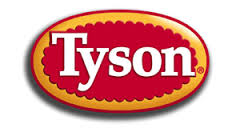 Tyson Foods Inc has reported a 28% increase in quarterly profit, which was better than expected, helped by an increase in beef sales and said it expected that meat production would increase during the current fiscal year.
Tyson Foods Inc has reported a 28% increase in quarterly profit, which was better than expected, helped by an increase in beef sales and said it expected that meat production would increase during the current fiscal year.
Shares of the largest meat processor in the U.S. were up 5% in early trading. The stock has increased by 72% over the past year.
Tyson announced it expected that production of pork, beef, turkey and chicken to increase approximately 1% during the fiscal year that ends in September of 2014. Production dropped by 0.2% during the 2013 fiscal year.
The company also should benefit as the prices of corn and some other feeds pull back. Tyson expects higher supplies in grain during the 2014 fiscal year, which will result in costs being lower.
Tyson said full fiscal year sales would be $36 billion, which is higher than the analysts’, which was $35.67 billion.
Tyson also announced that Jim Lochner, its COO would be retiring in September when the fiscal year 2014 ends.
Analysts expect Tyson’s chicken production in the U.S. to increase at a faster rate than forecasted by the company, which was between 3% and 4%.
The company announced it expects hog supplies to be up between 1% and 2% during fiscal year 2014.
Analyst also said the higher pork and beef prices should keep the demand for chicken higher. Tyson’s sales for chicken were up 2.4% to more than $3.16 billion during the quarter that ended September 30, which accounted for nearly 36% of its total sales.
Sales of beef were up 4% to over $3.75 billion, which represented close to 42% of all sales.
Sales of pork were down 5.6% to just over $1.4 billion. Total sales for the company based in Arkansas were up 7% to more than $8.89 billion, which was in line with estimates from analysts.
